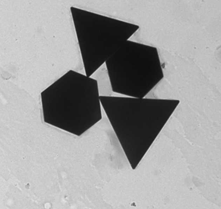All About Gold Nanoplates
Definition, Properties, Uses and Applications
Gold nanoplates are a unique class of nanomaterials that have garnered significant attention due to their appealing structural and optical properties. The synthesis of gold nanoplates has been a subject of extensive research, with a focus on achieving high yield and precise control over their morphological characteristics. Chen et al. (2014) highlighted the challenges in synthesizing gold nanoplates, including the lack of a clear understanding of the growth mechanism and low morphological yield, which has impeded their practical applications. However, subsequent studies have made significant progress in addressing these challenges. For instance, Chen et al. (2016) reported a rapid seedless synthesis of gold nanoplates with microscaled edge length in high yield, which were further employed as surface-enhanced Raman scattering substrates. This demonstrates the potential of gold nanoplates in applications such as sensing and spectroscopy.
The unique properties of gold nanoplates have led to their application in various fields. For instance, Ma et al. (2022) demonstrated the use of microscale single-crystal gold nanoplates as nanocatalysts, showcasing their excellent catalytic activity and recyclability in heterogeneous catalysis applications. Furthermore, Jiang et al. (2021) synthesized gold nanoplates using plant molecules and investigated their application in electrochemical sensing of lead ions, highlighting the versatility of these nanomaterials in diverse fields. Additionally, Major et al. (2013) discussed the optical and dynamical properties of chemically synthesized gold nanoplates, shedding light on their potential applications in photonics and optoelectronics.
The unique plasmonic properties of gold nanoplates have also been a subject of investigation. Beane et al. (2017) studied surface plasmon polariton interference in gold nanoplates, providing insights into their optical behavior and potential applications in plasmonics. Furthermore, Yang et al. (2015) investigated the control of wave-vector of propagating surface plasmon polaritons on single-crystalline gold nanoplates, offering valuable information for the design of plasmonic devices.
The synthesis and functionalization of gold nanoplates have also been explored for specific applications. For instance, Osonga et al. (2019) presented a rapid and greener photochemical synthesis of gold nanoplates using quercetin diphosphate macromolecules, showcasing the potential for environmentally friendly synthesis routes. Additionally, Guo et al. (2015) obtained gold nanoplates through changes in surfactant concentration, demonstrating the tunability of nanoplate shapes for specific applications such as nucleic acid delivery.
In conclusion, gold nanoplates exhibit unique properties that make them promising for a wide range of applications, including catalysis, sensing, photonics, and optoelectronics. The advancements in their synthesis and functionalization have paved the way for their utilization in various fields, with ongoing research aimed at further exploring their potential in diverse applications.
Go here for Nanopartz Gold Nanoplates
References:
Beane, G., Yu, K., Devkota, T., Johns, P., Brown, B., Wang, G., … & Hartland, G. (2017). Surface plasmon polariton interference in gold nanoplates. The Journal of Physical Chemistry Letters, 8(19), 4935-4941. https://doi.org/10.1021/acs.jpclett.7b02079
Chen, L., Ji, F., Xu, Y., He, L., Mi, Y., Bao, F., … & Zhang, Q. (2014). High-yield seedless synthesis of triangular gold nanoplates through oxidative etching. Nano Letters, 14(12), 7201-7206. https://doi.org/10.1021/nl504126u
Chen, S., Xu, P., Li, Y., Xue, J., Han, S., Ou, W., … & Ni, W. (2016). Rapid seedless synthesis of gold nanoplates with microscaled edge length in a high yield and their application in sers. Nano-Micro Letters, 8(4), 328-335. https://doi.org/10.1007/s40820-016-0092-6
Guo, J., Armstrong, M., O'Driscoll, C., Holmes, J., & Rahme, K. (2015). Positively charged, surfactant-free gold nanoparticles for nucleic acid delivery. RSC Advances, 5(23), 17862-17871. https://doi.org/10.1039/c4ra16294c
Jiang, X., Ma, J., Jiang, G., Xu, M., Huang, X., Gao, G., … & Dai, X. (2021). Preparation of gold nanoplates using ortho carbonyl compounds as capping agents for electrochemical sensing of lead ions. Nanoscale Research Letters, 16(1). https://doi.org/10.1186/s11671-021-03521-2
Ma, A., Yang, W., Yan, H., & Tang, J. (2022). Substrate-free fabrication of single-crystal two-dimensional gold nanoplates for catalytic application. Langmuir, 38(49), 15263-15271. https://doi.org/10.1021/acs.langmuir.2c02404
Major, T., Devadas, M., Lo, S., & Hartland, G. (2013). Optical and dynamical properties of chemically synthesized gold nanoplates. The Journal of Physical Chemistry C, 117(3), 1447-1452. https://doi.org/10.1021/jp311470t
Osonga, F., Kariuki, V., Wambua, V., Kalra, S., Nweke, B., Miller, R., … & Sadik, O. (2019). Photochemical synthesis and catalytic applications of gold nanoplates fabricated using quercetin diphosphate macromolecules. Acs Omega, 4(4), 6511-6520. https://doi.org/10.1021/acsomega.8b02389
Yang, H., Yang, Y., Zhao, D., Chen, X., Qiu, M., & Li, Q. (2015). Controlling wave-vector of propagating surface plasmon polaritons on single-crystalline gold nanoplates. Scientific Reports, 5(1). https://doi.org/10.1038/srep13424

